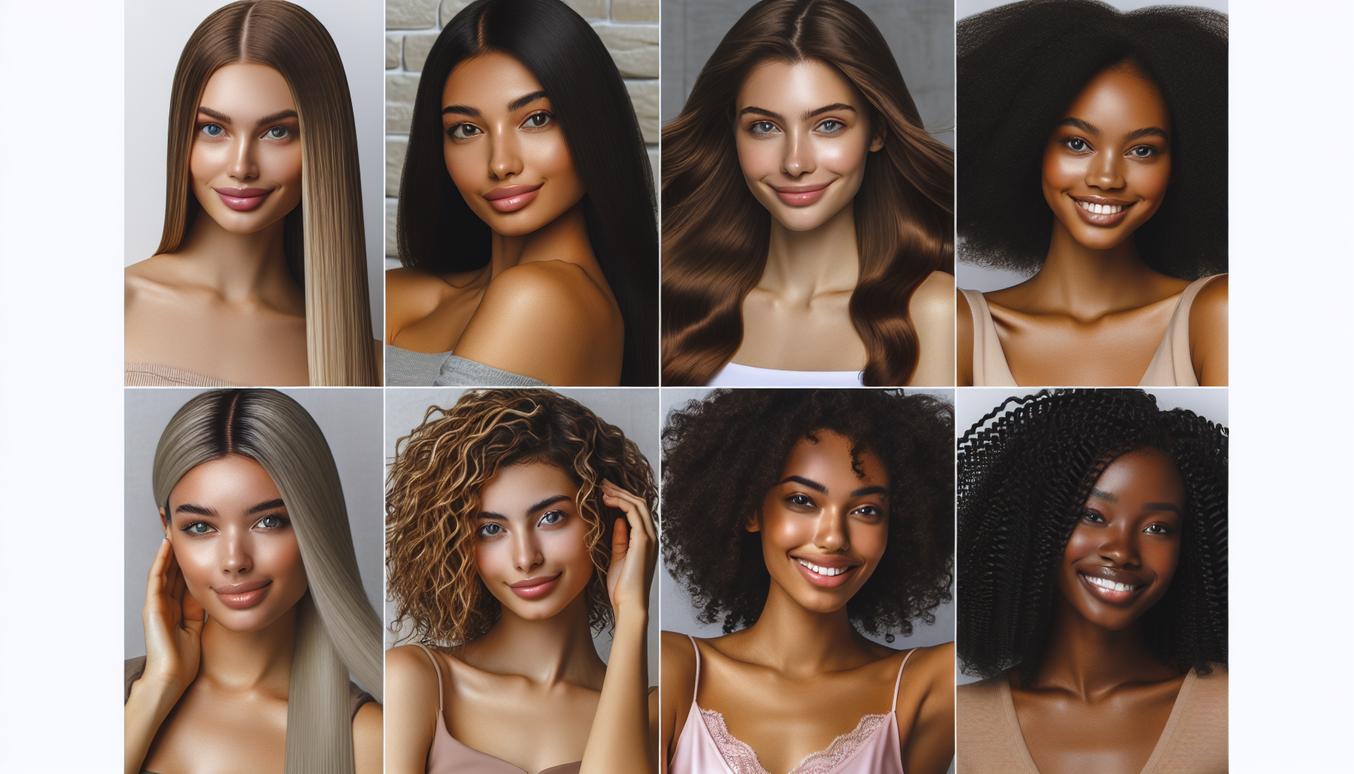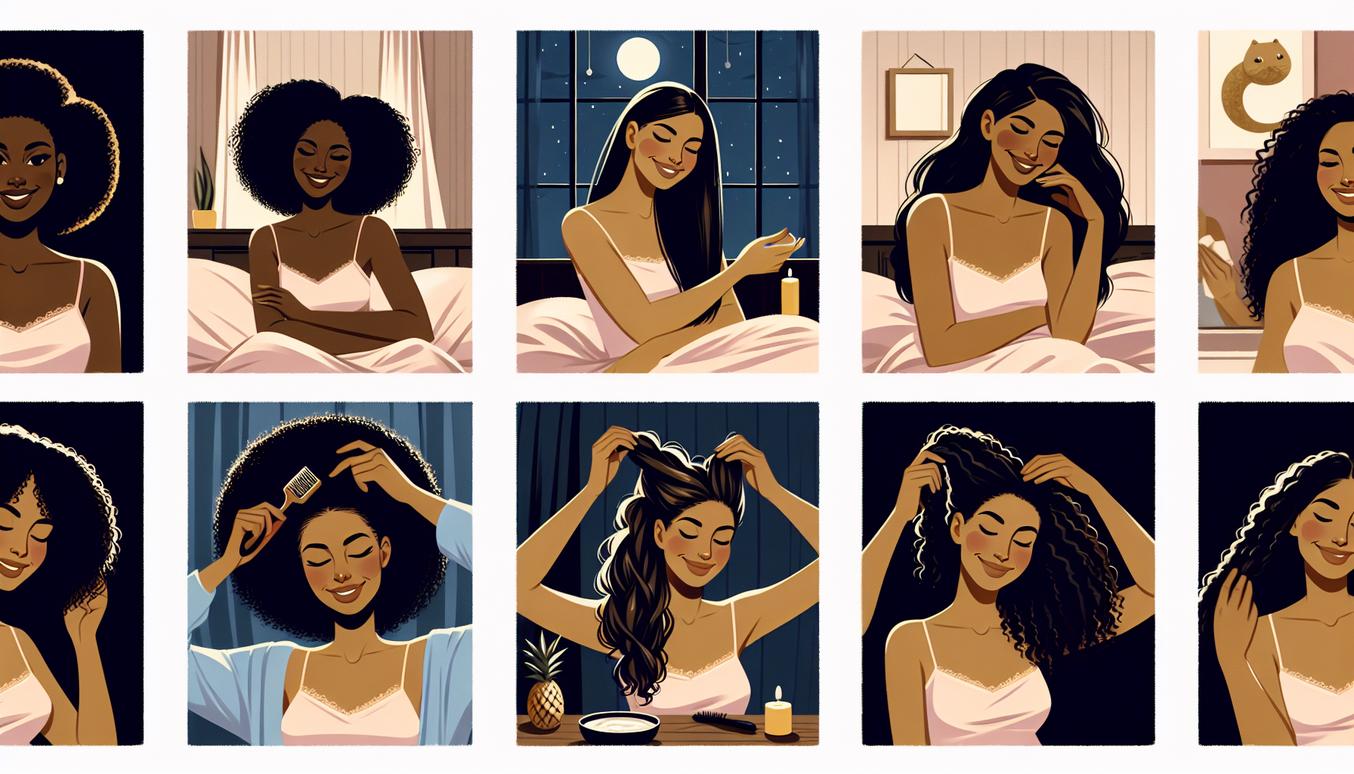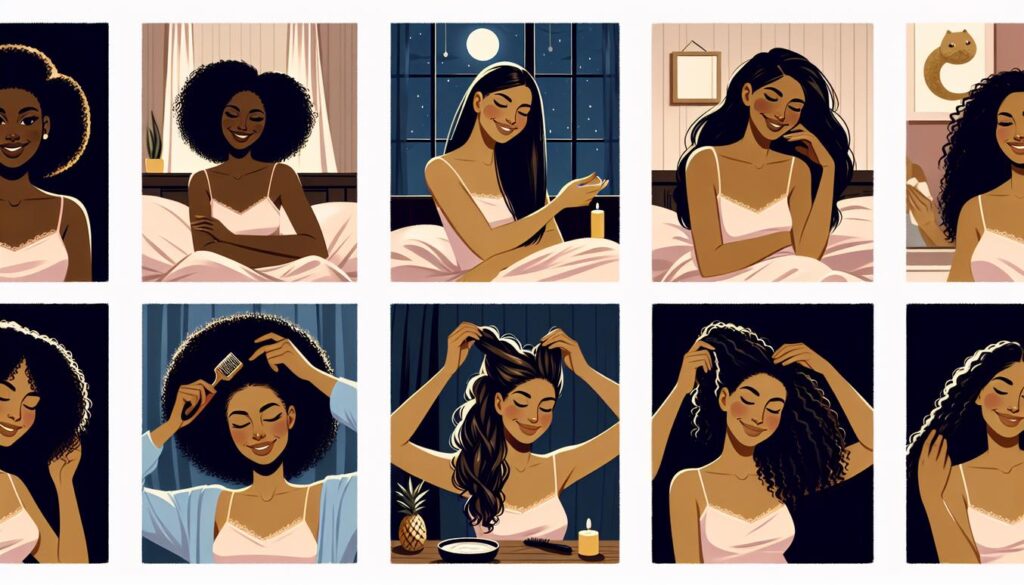Your Ultimate Guide to Hair Types: A Texture-First Roadmap to Healthy Hair
Welcome to your complete guide to understanding hair types. If you have ever felt overwhelmed by the sheer volume of hair care advice, you are not alone. The secret to unlocking your hair’s true potential is not about finding a single magic product, but about deeply understanding its unique characteristics. This guide moves beyond simple categories, offering a texture-first roadmap that connects your specific hair type to its porosity, lifestyle, and a simple, effective routine. By the end, you will have the knowledge to build a personalised care plan that works for you, leaving you feeling confident and in control of your hair health journey.
Understanding Hair Anatomy: From Root to Strand
Before diving into the different hair types, it is helpful to understand what hair actually is. Knowing the basic structure of your hair provides the foundation for all effective hair care.
The Hair Follicle: Where It All Begins
Every strand of hair on your head grows from a hair follicle, a small, pocket-like structure in your scalp. The shape of the follicle is a primary determinant of your hair’s texture. Round follicles typically produce straight hair, while oval or flattened follicles produce wavy, curly, or coily hair. This is why your fundamental hair type is genetic and cannot be permanently changed without chemical treatments.
The Hair Strand: Cuticle, Cortex, and Medulla
Each individual hair strand is composed of three main layers:
- The Cuticle: This is the outermost, protective layer, made up of overlapping scales, much like tiles on a roof. A healthy, closed cuticle results in smooth, shiny hair that is less prone to damage.
- The Cortex: The middle layer, which makes up the bulk of the hair strand. It contains the proteins (keratin) and pigment (melanin) that give your hair its strength, elasticity, and colour.
- The Medulla: The innermost, core layer of the hair shaft. It is not always present, especially in people with very fine hair. Its exact function is still not fully understood by scientists.
The Four Primary Hair Types: Straight, Wavy, Curly, and Coily
The most widely recognised system categorises hair into four primary types, based on the hair’s curl pattern or lack thereof. Understanding which of these main hair types you have is the first step in customising your routine.
Type 1: Straight Hair
Straight hair grows straight down from the root without any bend or curl. Because the path from the scalp to the ends is direct, natural oils (sebum) can travel down the shaft easily. This often makes straight hair appear shiny but can also cause it to become oily or greasy more quickly than other hair types.
Type 2: Wavy Hair
Wavy hair has a natural “S” shape. It sits in a middle ground between straight and curly, with more volume than straight hair but a less defined curl than curly hair. This hair type can be prone to frizz, especially in humid conditions, and may require lightweight products to enhance its natural pattern without weighing it down.
Type 3: Curly Hair
Curly hair strands form defined loops or corkscrews. The follicles are typically oval-shaped, causing the hair to grow out in a distinct spiral pattern. Curls are often voluminous but can be prone to dryness and frizz, as the sebum from the scalp has a harder time travelling down the winding path of the hair shaft.
Type 4: Coily Hair
Coily hair, also known as kinky or Afro-textured hair, features the tightest curl pattern, ranging from small, tight “S” or “Z” shaped coils to tight zig-zags. This hair type is often very fine and fragile, making it the most susceptible to dryness and breakage. It requires significant moisture to maintain its health and elasticity.
Spotting Subtypes and Common Myths
Within the four main hair types, there are further classifications that help to pinpoint your texture more accurately. This system helps refine your product choices and styling techniques.
Decoding the A, B, C System
Each of the four hair types is broken down into three subcategories: A, B, and C. This classification refers to the width or diameter of your hair’s pattern.
- Subtype A: The widest and loosest pattern within its type (e.g., 2A has loose, tousled waves).
- Subtype B: A medium, more defined pattern (e.g., 3B has springy, ringlet curls).
- Subtype C: The tightest and most defined pattern (e.g., 4C has a tight, Z-shaped coil with significant shrinkage).
It is very common to have multiple hair types and subtypes on your head. For instance, you might have 3B curls at the crown and 3A curls near your neck.
Busting Common Hair Type Myths
Misinformation can lead to poor hair care habits. Let’s clear up some common myths:
- Myth 1: Oily hair needs to be washed every day with a harsh shampoo. In reality, overwashing can strip the scalp, causing it to produce even more oil to compensate. A gentle, sulfate-free cleanser is often a better choice.
- Myth 2: You cannot have fine and curly hair. Hair density (how many strands you have) and hair thickness (the diameter of each strand) are separate from your curl pattern. You can absolutely have fine Type 3 or Type 4 hair.
- Myth 3: All curly and coily hair types are coarse. Many people with curly and coily patterns have very fine strands that are densely packed together, creating the appearance of thick hair. These fine strands are often more fragile.
Hair Porosity Explained and How to Test It at Home
Beyond your curl pattern, hair porosity is arguably the most critical factor in determining how your hair behaves and what products it needs. It refers to your hair’s ability to absorb and retain moisture.
What is Hair Porosity?
Porosity is determined by the state of your hair’s cuticle layer.
- Low Porosity: The cuticles are tightly packed and flat. This makes it difficult for moisture to get in, but once it is in, it is retained well. Products tend to sit on top of the hair.
- Medium (or Normal) Porosity: The cuticles are slightly raised, allowing moisture to enter and exit at a balanced rate. This is generally considered the easiest hair type to manage.
- High Porosity: The cuticles are widely spaced or have gaps, often due to damage from chemical treatments or heat. This hair absorbs moisture very quickly but loses it just as fast, leading to frizz and dryness.
The Simple Float Test
You can get a good idea of your hair’s porosity with this easy at-home test:
- Take a clean, dry strand of your hair (from your brush is fine).
- Drop the strand into a glass of room temperature water.
- Observe what happens over the next 2-4 minutes.
- If it floats at the top, you likely have low porosity hair.
- If it sinks slowly, you likely have medium porosity hair.
- If it sinks quickly to the bottom, you likely have high porosity hair.
Choosing Cleansers and Conditioners for Your Texture
Your shampoo and conditioner are the foundation of your routine. Choosing the right ones based on your hair type and porosity is essential for hair health.
Choosing the Right Cleanser for Your Hair Type
The goal of a cleanser is to remove dirt, oil, and product buildup without stripping your hair of its natural moisture.
- For Straight and Wavy Hair (Types 1 and 2): A lightweight, sulfate-free shampoo is often ideal. If you experience oiliness or buildup, using a clarifying shampoo once every couple of weeks can be beneficial.
- For Curly and Coily Hair (Types 3 and 4): These hair types benefit from moisture-rich, creamy cleansers. Co-washing (using a cleansing conditioner instead of shampoo) is a popular option to preserve moisture. A clarifying shampoo should be used periodically to remove buildup that can weigh down curls.
Finding Your Perfect Conditioner
Conditioner works to smooth the cuticle, add moisture, and improve manageability.
- Low Porosity Hair: Needs lightweight, hydrating conditioners that will not cause buildup. Look for products with humectants like glycerin. Applying conditioner to warm, damp hair can help the cuticle open to absorb the product.
- High Porosity Hair: Requires rich, creamy conditioners with sealing ingredients like shea butter or oils to help fill the gaps in the cuticle and lock in moisture. Protein treatments can also help strengthen the hair strand.
Oils, Serums, and Deep Treatments: When to Use Them
Adding treatments to your routine can target specific concerns and elevate your hair’s health.
When to Use Oils and Serums
Oils and serums can add shine, reduce frizz, and protect the hair. Lighter oils like argan or jojoba are great for finer hair types, while heavier oils like castor or coconut oil work well for sealing moisture into coily or high porosity hair. Serums, often silicone-based, are excellent for creating a protective barrier against humidity and heat.
The Power of Deep Conditioning and Masks
A deep conditioner or hair mask provides an intensive dose of moisture and nutrients. How often you should use one depends on your hair’s needs:
- For most hair types: Once a week is a great starting point.
- For dry or damaged high porosity hair: You may benefit from using a mask twice a week.
- For low porosity or fine hair: Once every two weeks might be sufficient to avoid weighing the hair down.
Styling with Care: Heat, Protection, and Low-Heat Alternatives
Styling gives us a way to express ourselves, but it is important to do so in a way that minimises damage.
The Golden Rule of Heat Styling
If you use heat tools like flat irons, curling wands, or blow dryers, a heat protectant is non-negotiable. This product creates a barrier between your hair and the high temperature, significantly reducing the risk of damage, breakage, and moisture loss. Always use the lowest effective heat setting for your hair type.
Embracing Low-Heat and No-Heat Styles
Giving your hair a break from heat is one of the best things you can do for its health. Exploring low-heat and no-heat styling options can deliver beautiful results without the damage. Consider techniques like:
- Heatless Curls: Using flexi-rods, rollers, or even a bathrobe tie to create curls overnight.
- Protective Styles: Braids, twists, and updos can protect your ends from friction and environmental damage.
- Air-Drying Methods: Learning to “plop” wavy or curly hair with a t-shirt or using styling creams to define your natural texture while it air-dries.
Routine Templates: Morning, Weekly, and Pre-Shampoo
Consistency is key. Here are some simple templates you can adapt to create a routine that fits your lifestyle and specific hair needs.
A Sample Weekly Hair Care Schedule
| Day | Activity | Notes for Different Hair Types |
|---|---|---|
| Day 1 (Wash Day) | Pre-shampoo (optional), cleanse, condition, deep condition, apply leave-in and stylers. | Coily types may pre-shampoo with oil. Straight types can skip deep conditioning if hair is healthy. |
| Day 2-3 | Refresh and restyle. | Wavy/Curly types can spritz with water and add a little product. Straight types may use dry shampoo. |
| Day 4 | Light refresh or style in an updo. | A great day for a protective style like a braid or bun for all hair types. |
| Day 5-7 | Assess hair. Wash if needed, or continue with low-manipulation styles. | Listen to your hair. If your scalp is itchy or hair is weighed down, it is time for another wash day. |
Quick Morning Routines for Different Hair Types
- Straight: Brush through, apply a touch of anti-frizz serum to the ends, and use dry shampoo at the roots if needed.
- Wavy: Lightly mist with water to reactivate yesterday’s product. Scrunch with a small amount of mousse or cream to redefine waves.
- Curly/Coily: Protect curls at night with a silk scarf or bonnet. In the morning, gently shake out hair, fluff at the roots, and spot-treat any frizzy or undefined curls with water and a leave-in conditioner.
Inside-Out Care: Nutrition, Hydration, and Scalp Practices for Growth
Healthy hair starts from within. What you eat and how you treat your scalp have a direct impact on your hair’s growth and strength.
Fueling Your Hair from Within
A balanced diet rich in vitamins and minerals is crucial for hair health. Key nutrients include:
- Protein: The building block of hair (keratin). Found in eggs, lean meats, and legumes.
- Iron: Essential for oxygen transport to follicles. Found in spinach, red meat, and lentils.
- Biotin: A B-vitamin linked to hair growth. Found in nuts, seeds, and sweet potatoes.
- Omega-3 Fatty Acids: Supports scalp health. Found in fatty fish like salmon and flaxseeds.
Staying hydrated by drinking plenty of water is also fundamental for overall health, which is reflected in your hair.
The Importance of a Healthy Scalp
Think of your scalp as the garden from which your hair grows. A clean, balanced, and stimulated scalp creates the best environment for healthy hair growth. Incorporate simple practices like regular, gentle cleansing to prevent buildup, and perform weekly scalp massages with your fingertips to boost circulation to the hair follicles.
Troubleshooting Common Hair Concerns
Even with a great routine, you may encounter some common hair issues. Here is how to tackle them by understanding their link to different hair types and porosity.
- Frizz: This is often a sign that your hair is dehydrated and is trying to pull moisture from the air. The solution is to add more moisture through deep conditioners, leave-in conditioners, and sealing oils. This is especially common for wavy, curly, and high porosity hair.
- Breakage: Can be caused by dryness, rough handling, or excessive heat. Focus on gentle detangling (from the ends up), using protective styles, and incorporating protein treatments if your hair is highly porous and damaged.
- Limpness: If your hair feels flat and weighed down, it is likely due to product buildup or using products that are too heavy for your hair type. Use a clarifying shampoo and opt for more lightweight stylers. This is a common issue for fine or low porosity hair.
- Buildup: A sticky or dull feeling on the hair is a clear sign of buildup from products, oils, or hard water. A regular clarifying wash is the best way to reset your hair and scalp.
Personalising a Long-Term Care Plan
Your hair’s needs are not static. The perfect routine is one that evolves with you.
Adapting Your Routine for 2025 and Beyond
Keep in mind that your hair can change over time due to hormones, age, and environmental factors. Your hair care strategy for 2025 should be flexible. For example, you may need more moisture in the dry winter months and more lightweight, anti-humectant products in the humid summer. If you move to a new city, the water hardness can affect your hair, potentially requiring more frequent clarifying.
Listening to Your Hair: The Ultimate Guide
The most important part of any hair care plan is observation. Pay attention to how your hair feels and looks after you use certain products or try new techniques. Is it soft and defined? Or is it dry and brittle? This direct feedback is your best guide. Do not be afraid to experiment and adjust your routine. The goal is not to follow a rigid set of rules, but to create a responsive, personalised plan that celebrates your unique hair.
Resources, Quick Charts, and Final Thoughts
Your journey to understanding your hair is a continuous and rewarding one. Use the information here as your starting point and continue to learn and adapt.
At-a-Glance Reference Charts
Consider creating a simple printable chart for your bathroom mirror. It could include:
- Your Hair Type and Subtype: (e.g., 3B/3C)
- Your Porosity: (e.g., High)
- Weekly Goals: (e.g., 1x Deep Condition, 2x Scalp Massage)
- Key Ingredients to Look For: (e.g., Shea Butter, Protein)
- Key Ingredients to Avoid: (e.g., Heavy Oils)
Further Reading and Professional Advice
For more in-depth information or if you are experiencing significant hair issues, it is always best to consult with professionals. Here are some trusted resources:
- For expert advice and high-quality educational content, you can explore platforms like Rich Hair UK.
- If you are concerned about hair thinning or loss, the NHS – Hair Loss page provides reliable medical information.
- For scalp conditions or persistent issues, seeking advice from a certified dermatologist is recommended. The British Association of Dermatologists can help you find a specialist.
By identifying your specific hair types, understanding porosity, and committing to a consistent and gentle routine, you are well on your way to achieving your healthiest hair ever. Embrace your natural texture and enjoy the process of getting to know your unique hair.





